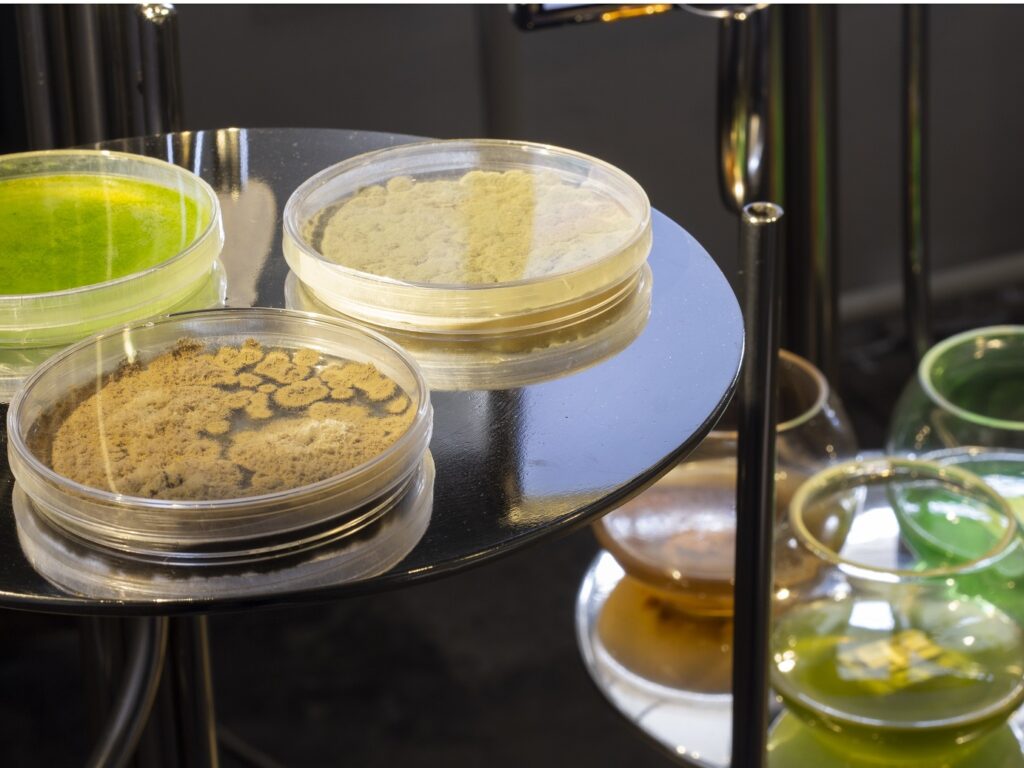Epidermitecture is a phenomenon explored by geo-microbiologists and architects that describe the relationship between naturally occurring stains on facades of buildings and its materialities. We rarely perceive spots or any discoloration formed on outer architectural surfaces because they are usually considered as dirt or simply subject of removal.
However, these stains, scientifically called Biopatina, are in fact a thin layer of living microorganisms such as cyanobacteria, microalgae, fungi and lichen that has the ability to restore and regenerate the environment.
The investigation of Biopatina on Villa Tugendhat brought us to question what the outside of this particular building needs to look like and why almost all architectural surfaces need to be maintained to appear as new rather than those that transform,
live and become? By collecting, analysing and cultivating the Biopatina of Tugendhat house, we explored its non-human materiality that came to existence as the result of natural processes between its interiors, outer surfaces and the surrounding environment. The aim of the exhibition ‘Epidermitecture’ is to acknowledge that microbial nonhuman life is essential in functional and lasting models for co-existence in contrast to anthropocentric assumptions that arguably brought us towards the multi-layered crises which we are collectively confronted with.

Almost all architectural and urban surfaces are conditioned to be maintained and protected with weather-resistant coatings to obtain their desired state,1 yet all material components go through an inescapable cycle of changes.
This inevitable transformation, which affects all surfaces of Villa Tugendhat, is not only caused by dynamic forces such as wind and rain, but is also the result of microorganism activity. Any naturally occurring stains on facades are usually considered a subject of removal, dating back to the ancient Greeks2 and their ceremonies of cleaning sculptures during festivities. What happens when we question what the outside of a building needs to look like and why? And how might this deepen our understanding of what grows on the surface?
Biopatina, a thin layer of micro-organisms on architectural organic skin, is a symbiosis of cyanobacteria, microalgae, fungi, and lichen that metamorphose, change, and respond to its environments. The results of their activities affect how material surfaces transform visually in terms of colour, texture, and structural integrity. Epidermitecture is primarily concerned with biopatina’s microorganisms and their ability to restore and regenerate the environment. Furthermore, acknowledging microbial life is essential for conceiving functional and lasting models for co-existence in contrast to anthropocentric assumptions that arguably propelled us towards the imminent destruction of our habitat and the layered crises which we are collectively confronted with.3
The ongoing notion of preservation of Villa Tugendhat, employing the original’s materials and crafts, tries to maintain the appearance of Villa Tugendhat as “frozen in time” and ignores the interaction of its outer surfaces with the environment. How urgent and necessary are the efforts to eliminate the aesthetically distressing changes to Villa Tugendhat’s initial appearance and the intended
architectural organic skin?
Given the relevance and complexity of the facade’s biogeochemical processes, an initial multidisciplinary study of outer surfaces of Villa Tugendhat was conducted. By collecting, analysing, cultivating, and representing the biopatina of Villa Tugendhat together with microbiologists from the Academy of Fine Arts in Vienna, we aim to establish new ways to maintain buildings by proposing socalled ‘bio-restoration’4 of the cultural heritage. By celebrating rather than suppressing nonhuman biogenic growth on the architectural organic skin, we propose to coexist with nonhuman life forms that are an intrinsic part of architecture and the environment. Based on the preliminary result of our study, it is not necessary to maintain the outer surfaces of Villa Tugendhat biopatinafree, as intended in current maintenance practice, but rather explore its potential to protect and regenerate both the surface and the environment. Observations made on-site led us to the discovery that biopatina is often perceived as the result of a technological error: it is usually found in places where the interior penetrates the exterior, in small cracks, in moist corners, and in places that nurture and support biopatina growth.
1 For a discussion about the protective layer of paint, see Ingrid Halland and Marte Johnslien, “‘With-On’ White: Inconspicuous Modernity with and on Aesthetic Surfaces, 1910–1950,” Aggregate 11 (January 2023).
2 Greek sources refer to the ritual attention to and ordinary maintenance of marble sculptures as therapeia, kosmesis, and apikosmesis; Elisabetta Neri, Nesrine Nasr, and David Strivay, “Ancient Restoration in Roman Polychromy: Detecting Aesthetic Changes?”, Heritage 5, no. 2 (2022): 829-848, https://doi.org/10.3390/heritage5020045.
3 As argued by numerous scholars within the posthuman turn, see for instance Timothy Morton, Hyperobjects: Philosophy and Ecology after the End of the World, Posthumanities (Minneapolis: University of Minnesota Press, 2013).
4 Bio-restoration is a term used to describe the methodology of interdisciplinary research and will be investigated in the upcoming exhibition in Villa Tugendhat (February–May 2023).
Adam Hudec is a researcher/artist/architect and PhD candidate at Academy of Fine Arts in Vienna, focusing his multidisciplinary research on physical territory, often deconstructed by a set of data to reveal the unexpected and hidden anomalies. Operating at the intersection of art, science and architecture, interdisciplinarity became his tool to investigate hidden and invisible phenomena of the environment.
Link to the full essay about research
https://metode.r-o-m.no/en/articles/essay/epidermitecture-co-existing-on-the-surface
Collaborators
Katja Steflinger, Michelle Howard, Monika Mitášová, Jan Kristek, Beatrice Zaidenberg, Ingrid Halland, Jakub Węgrzynowicz,
Raffaella Lamuraglia, Vladimíra Hradecká, Barbora Benčíková, Michal Koštenský, Zuzana Sojková
Performance
Edita Antalová
Curator
Neli Hejduk
Part of microscopic analysis of Biopatina (microscopic video) was conducted at Georg-August University Göttingen by Marie Jamroszczyk using sample ‘SAG 42.79 Chroococcidiopsis thermalis’. More of Marie’s work can be found on her instagram page @_algaeworld_

